Tried & Tested
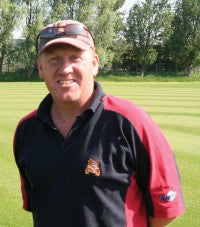 Stuart Kerrison, Head Groundsman for Essex County Cricket Club, explains his end of season renovation techniques.
Stuart Kerrison, Head Groundsman for Essex County Cricket Club, explains his end of season renovation techniques.
With the finish of the cricket season the important renovation work can commence. Here at Essex County Cricket Club we have used a couple of different methods for that renovation over the past few years. Our square is made up of 22 pitches of which six are practice nets, eleven are usable for First Class Cricket and five are used for middle practice and youth fixtures, due to the boundaries not being within ECB regulations. We treat all our pitches the same for our renovation work to ensure uniformity across the square.
Our first priority after the season's conclusion is to shave off the grass leaf to 3mm. Once this cut is made and the debris cleaned up we can begin scarifying. It is preferable to dampen off the surface of the square before this to allow easier penetration for the various machines that are to be used.
We have a tractor mounted Huxley scarifier which is 20 years old and it is just about still up to the job, although not for much longer I fear! With the blades set at 3mm depth we generally do 6-8 passes in a union jack pattern, the amount of passes dependant on the existing grass coverage. Again, the debris is removed from the square, firstly with a Hayter rotary, then a mechanical brush and, finally, another cut with the cylinder mower set at 3mm. This should leave a clean and scarred surface.
Our tractor mounted Sisis Vari-seeder is then employed to dimple the surface; this will leave dimples approx 4-5mm deep over the entire surface of the square for a seed bed. This procedure is done across both diagonals first, and then seed is distributed with a spinning disc applicator, followed by drag brushing the seed into the dimple holes.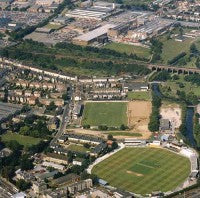
There are then another two passes with the vari-seeder, seeding and then brushing again to finish off. If required, a further dimpling pass and seeding is carried out dependant upon the degree of grass plant removed during scarifying.
We apply three bags of grass seed across the 22 pitch square. The last two autumn's we have used Bar-Extreme, a 100% Perennial Ryegrass mix, and have been very pleased with the characteristics of the grass. There has been rapid establishment, coupled with a fine and hard wearing sward.
Next on the agenda is topdressing. We have been using Ongar Loam Plus from CH Binders for the past fifteen years. We always get it delivered bagged for ease of use and have never been disappointed with the quality of this loam. It also helps that their yard is only twenty minutes up the road! The dressing is applied with a Sisis Truspread and we use approximately six 25kg bags per pitch. Each pitch here at Chelmsford is 90 feet long to ensure a solid run in for the bowlers.
After the scarifying and dimple seeding there is usually a slightly disturbed surface for amelioration of the dressing with the existing soil. This blending in is further enhanced by hand luting the loam across the line of play to cover the seed and fill any scuffs and marks from recent renovation work and match play. To finish off we usually run our 36" Allett Regal across the square to settle down the dressing, and we find that this helps stop some run off if there is heavy rain.
Gro-covers are now used to encourage early germination and an application of a pre-seeding fertiliser, 6:9:6 or the like, helps to get the sward off to a good start.
This is our regular programme of renovation at season's end, however, we have twice fraise mown the square in the last three years, and this replaces the scarifying in the process aforementioned. The rest of the programme is the same, with the addition of an extra bag of grass seed to compensate for the extreme clearance of the grass cover, and a slightly heavier topdressing, approximately 1-2 extra bags per pitch.
The fraise mowing was done over three finely adjusted passes and removed 4-5mm in total each of the two autumn's we did it. This left us with a very clean profile from 200mm down right to the surface, with the organic matter being what had grown that year.
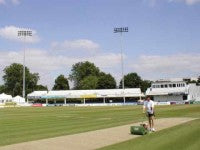

Following on from the end of season work will be regular inspections for disease and any seeding and topdressing of spots which had not taken, usually in the creases.
With regard to aeration, we generally leave this until mid-November to allow the ground to soften slightly for maximum penetration and cost effective use of the machine used.
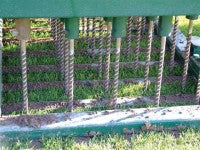
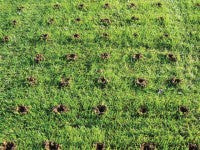
The Deep Drill aerator from Ecosolve has been our favourite for aeration for over fifteen years now and, with the minimum of disruption and heave that this machine gives, makes it ideal for cricket squares. The spoil brought to the surface by the drill bits needs to be well dispersed either by switching, drag matting, with besoms, etc, a bit like topdressing.
his needs to be carried out before the spoil gets wet and makes a muddy mess not dissimilar to worm casts. The other thing is to give the surface a light roll as soon as conditions allow; we use our Allett Regal once again. It usually feels a bit corrugated the first time, this is due to the slight lip around each drill hole but, once rolled, this is hardly noticeable when the grass is tipped through the winter.
These are the tried and tested methods we have used over the past eighteen years and we have had excellent results from these techniques.
